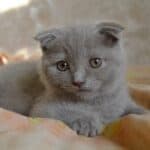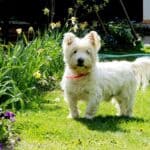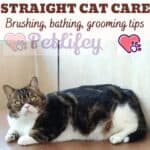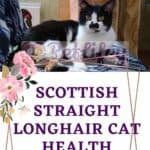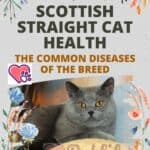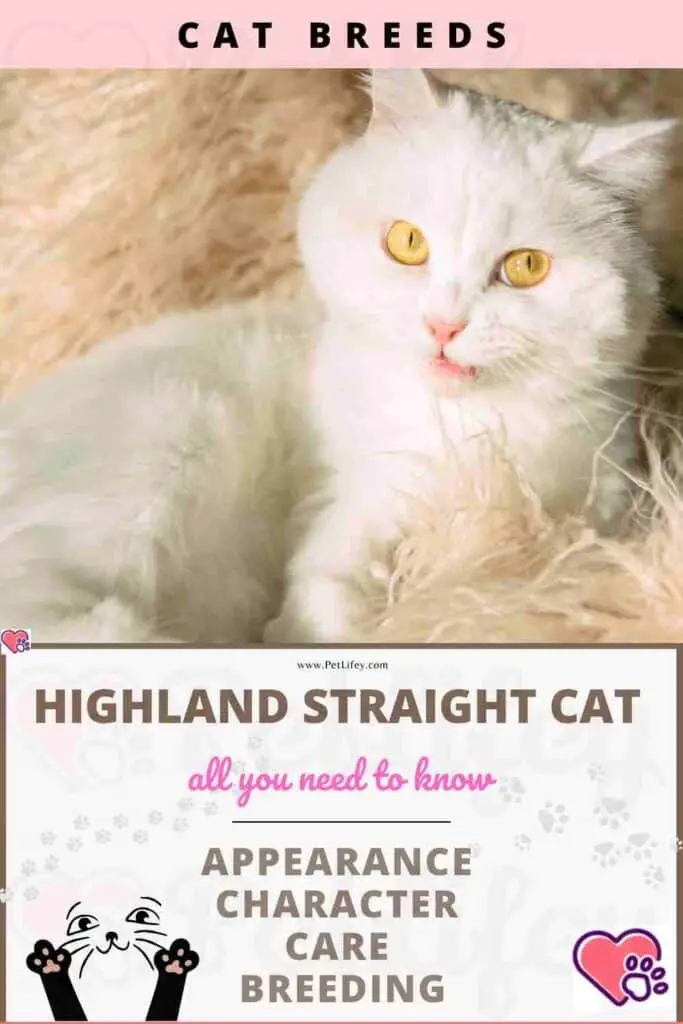
Halfway between Scottish and British, the Highland straight cat carries with him the characteristics of his parents, and this makes them an ideal life companion, as much for adults as for children, eager to pay attention and love to their little feline!
The origins of the Highland Straight Cat
Scottish and Highland history begins in the 1960s. Shepherds Mary and William Ross notice a cat with ears bent forward on a Scottish farm called Suzie. In 1963, the Rosses acquired Snook, a white female, daughter of Suzie.
With her began the Scottish Fold breeding program which consisted of marrying Susie’s descendants with British Shorthairs. The British being regularly crossed with Persians, some kittens, called Highland, were born with long hair.
The Highland straight is a Highland Fold with straight ears! The Highland Fold is the result of a cross between a Scottish Fold and a Persian. Although it is recognized as a breed apart in some clubs, it is considered a British longhair if (and only if) it has at least 18 British in their pedigree.
If this is not the case then it will be considered a house cat. What is the British doing? Well, quite simply because two Scottish Folds must not be mated together at the risk of creating an infirmity. This is why the Scottish Fold is generally crossed with a British.
If a kitten born to a British longhair and a Fold has straight ears, then it will be a Highland straight (and not a British shorthair).
Appearance of the Highland Straight Cat
The body of the Highland straight is sturdy, rounded, muscular and heavy. Its tail is medium and its paws well proportioned with round feet. It has a round head with full cheeks, a fairly short nose with a slight stop.
Its ears are erect of course, and it has two very round eyes. Its coat is silky, shorter on the shoulders but with a fuller ruff around the neck.
Coat color of the Highland Straight Cat
All coat colors are allowed, similar to Scottish fold .
The character of the Highland Straight Cat
Close to its owner, the Highland Straight is easy-going, calm, docile, and very sociable with humans and animals.
Hug:
Attached to their humans, this big teddy bear is happy to be cuddly at times it chooses.
Player:
Like many cats, it knows how to be calm but also appreciates moments of play which will allow them to exercise.
Calm:
It is a calm cat and easily docile, although it does not disdain a daily play session.
Intelligent:
Its adaptability to different lifestyles makes it an intelligent cat, with which it is good to live.
Fearful / Suspicious of Strangers:
Individual differences exist, but in general this feline easily adapts to new situations.
Independent:
Attached to their humans, it needs a benevolent and regular presence while knowing not to be intrusive.
Behavior of the Highland Straight Cat
Talkative: It ‘s really not a talkative cat, and he shouldn’t need to talk to you to be understood: it’s up to you to decipher its body language!
Greedy / glutton:
It is not known to be particularly greedy, which does not prevent to offer this tomcat a balanced diet.
Need for exercise:
Of a rather calm nature, it will still need to spend the energy recovered by his long naps. It is therefore appropriate to offer them a cat tree and daily play sessions to exercise them and encourage his feline instincts!
Runaway:
It is attached to his humans and does not necessarily have a great need for exploration.
Compatibility of the Highland Straight Cat with other animals
The Highland and the Dogs:
Of a sociable nature, it adapts quite easily to the company of other animals, including dogs.
The Highland and Other Cats:
As long as each individual can have their areas of rest, play, feeding and elimination, this breed easily adapts to the presence of other feline companions.
The Highland and the Children:
Easy going, it is well suited to a family life.
The Highland and the Elderly :
Its calm nature also makes it a good companion for a lonely and / or calmer person.
Price of the Highland Straight Cat
On average, the purchase price of a Highland kitten in breeding is between 700 USD and 1800 USD , the price often varying according to the line, the breeding, the age or even the sex. For the monthly budget, it will take an average of 35.61 USD / month to meet his needs, by offering him a quality diet and making sure to keep him in good health.
Maintenance of the Highland Straight Cat
Grooming:
A weekly brushing session is sufficient, except during the moulting period, when it is better to brush it daily.
Hair loss:
Except in spring, when it can get rid of part of their undercoat, it really does not tend to lose its hair.
Food of the Highland Straight Cat
Known for its calm, it is advisable to be vigilant on the nutritional quality and the quantity of food granted in order not to promote weight gain.
Caring for the Highland Straight Cat
Nothing special except more attention to brushing during the moulting period.
Health of the Highland Straight Cat
Life expectancy:
It has a normal life expectancy for a cat, between 13 and 15 years old , with strong individual differences, mainly according to the way of life.
Resistant / robust:
Its fairly dense undercoat makes it more tolerant of cold or humidity than of heat.
Tendency to
gain weight : Offering him daily play sessions is a good way to prevent him from gaining too much weight.
Frequent diseases:
Generally of robust health, it can still present the same pathologies as all the other cats. If he can have access to the outside, it is better that he be vaccinated against infectious diseases such as Coryza , Leucosis , Rabies and Typhus , according to veterinary advice. The variety “Straight” does not suffer from any hereditary disease.
Reproduction:
The average number of kittens per litter is 3.36.
As the “Fold” gene can cause the undesirable consequences described above, it is forbidden to reproduce two “Fold” individuals. One of the two parents must be straight-eared, knowing that the “Fold” gene is a dominant gene, although this “Straight” and “Fold” combination does not guarantee that individuals will not be affected by Osteochondrodyplasia.
The improvement of the herd is at the center of the concerns in order to avoid as much as possible the diseases linked to the “Fold” gene, thanks to a rigorous control of the individuals put to reproduction.
From 2002 to 2008, the LOOF only authorized the crossing of an individual “Fold” with the British Shorthair. Since 2008, new lines have appeared, through the use of American, Canadian and Russian subjects. Since 2015, crosses with the American Shorthair are also allowed.
The only marriages allowed for the Highland are: Scottish / Highland Fold & Scottish / Highland Straight; Scottish / Highland & British (Shorthair / Longhair) and Scottish / Highland & American Shorthair (since 2015).
Good to know
It was long believed that white “Fold” individuals had a propensity to deafness, but this deficiency is linked to the color of the coat and not to the shape of the ears. It has also been mistakenly believed that the “Fold” shape of the ears makes them prone to parasites.

